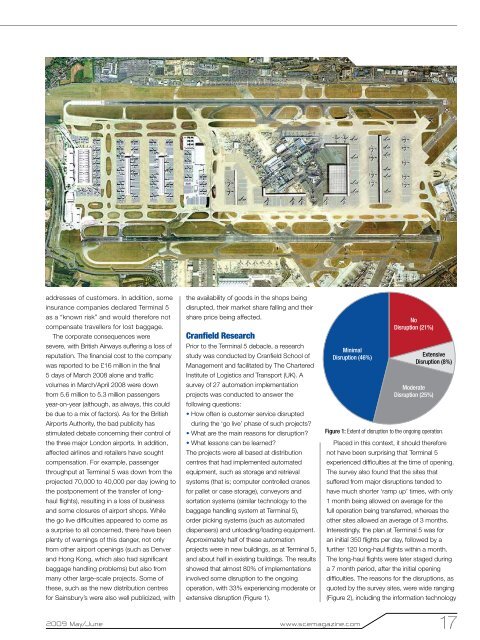w w w . s c e m a g a z i n e . c o m - Supply Chain Europe
w w w . s c e m a g a z i n e . c o m - Supply Chain Europe
w w w . s c e m a g a z i n e . c o m - Supply Chain Europe
Create successful ePaper yourself
Turn your PDF publications into a flip-book with our unique Google optimized e-Paper software.
addresses of customers. In addition, some<br />
insurance companies declared Terminal 5<br />
as a “known risk” and would therefore not<br />
compensate travellers for lost baggage.<br />
The corporate consequences were<br />
severe, with British Airways suffering a loss of<br />
reputation. The financial cost to the company<br />
was reported to be £16 million in the final<br />
5 days of March 2008 alone and traffic<br />
volumes in March/April 2008 were down<br />
from 5.6 million to 5.3 million passengers<br />
year-on-year (although, as always, this could<br />
be due to a mix of factors). As for the British<br />
Airports Authority, the bad publicity has<br />
stimulated debate concerning their control of<br />
the three major London airports. In addition,<br />
affected airlines and retailers have sought<br />
compensation. For example, passenger<br />
throughput at Terminal 5 was down from the<br />
projected 70,000 to 40,000 per day (owing to<br />
the postponement of the transfer of longhaul<br />
flights), resulting in a loss of business<br />
and some closures of airport shops. While<br />
the go live difficulties appeared to come as<br />
a surprise to all concerned, there have been<br />
plenty of warnings of this danger, not only<br />
from other airport openings (such as Denver<br />
and Hong Kong, which also had significant<br />
baggage handling problems) but also from<br />
many other large-scale projects. Some of<br />
these, such as the new distribution centres<br />
for Sainsbury’s were also well publicized, with<br />
the availability of goods in the shops being<br />
disrupted, their market share falling and their<br />
share price being affected.<br />
Cranfield Research<br />
Prior to the Terminal 5 debacle, a research<br />
study was conducted by Cranfield School of<br />
Management and facilitated by The Chartered<br />
Institute of Logistics and Transport (UK). A<br />
survey of 27 automation implementation<br />
projects was conducted to answer the<br />
following questions:<br />
• How often is customer service disrupted<br />
during the ‘go live’ phase of such projects?<br />
• What are the main reasons for disruption?<br />
• What lessons can be learned?<br />
The projects were all based at distribution<br />
centres that had implemented automated<br />
equipment, such as storage and retrieval<br />
systems (that is; computer controlled cranes<br />
for pallet or case storage), conveyors and<br />
sortation systems (similar technology to the<br />
baggage handling system at Terminal 5),<br />
order picking systems (such as automated<br />
dispensers) and unloading/loading equipment.<br />
Approximately half of these automation<br />
projects were in new buildings, as at Terminal 5,<br />
and about half in existing buildings. The results<br />
showed that almost 80% of implementations<br />
involved some disruption to the ongoing<br />
operation, with 33% experiencing moderate or<br />
extensive disruption (Figure 1).<br />
Minimal<br />
Disruption (46%)<br />
No<br />
Disruption (21%)<br />
Extensive<br />
Disruption (8%)<br />
Moderate<br />
Disruption (25%)<br />
Figure 1: Extent of disruption to the ongoing operation.<br />
Placed in this context, it should therefore<br />
not have been surprising that Terminal 5<br />
experienced difficulties at the time of opening.<br />
The survey also found that the sites that<br />
suffered from major disruptions tended to<br />
have much shorter ‘ramp up’ times, with only<br />
1 month being allowed on average for the<br />
full operation being transferred, whereas the<br />
other sites allowed an average of 3 months.<br />
Interestingly, the plan at Terminal 5 was for<br />
an initial 350 flights per day, followed by a<br />
further 120 long-haul flights within a month.<br />
The long-haul flights were later staged during<br />
a 7 month period, after the initial opening<br />
difficulties. The reasons for the disruptions, as<br />
quoted by the survey sites, were wide ranging<br />
(Figure 2), including the information technology<br />
2009 may/June www.scemagazine.com 17



